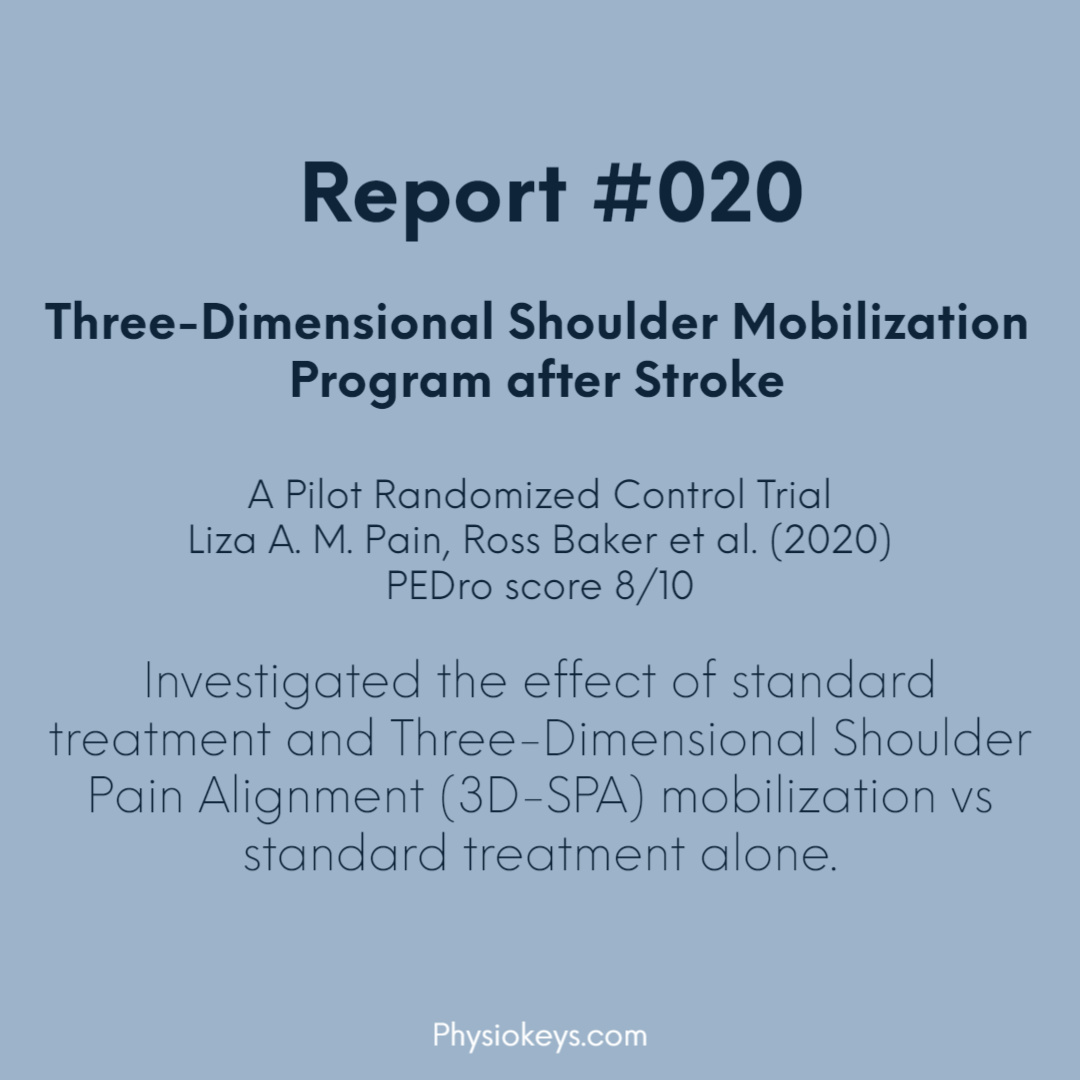#020-A 3D Shoulder Mobilization Program after Stroke
Estimated reading time: 2 minutes, 20 seconds.*
Three-Dimensional Shoulder Mobilization Program after Stroke
?Background and aim
- Post-stroke shoulder pain is a common complication, which stems from joint malalignment in the three-dimensional rotations of the clavicle, scapula and humerus, which in turn might contribute to shoulder conditions such as rotator cuff tendinopathy and more.
- The joint malalignment after stroke can be due to changes in muscle tone, timing and strength of muscle contraction, abnormal movement patterns and abnormal alteration in force coupling between opposing muscle group.
- The current standard treatment uses uni-dimensional mobilization.
- This pilot-RCT (PEDro score 8/10) investigated the effect of standard treatment and Three-Dimensional Shoulder Pain Alignment (3D-SPA) mobilization vs standard treatment alone.
?Interventions
60 minutes session, 3 sessions/week for 4 weeks.
After 4 weeks participants were given a home program for 30 days.
Current Standard treatment protocol:
- Passive ROM exercises.
- Active/assisted ROM exercises.
- Education regarding shoulder alignment positioning, and functional activity incorporating the hemiparetic limb.
3D-SPA:
- Three-dimensional clavicular mobilizations: elevation/depression, protraction/retraction, and anterior/posterior axial rotation.
- Scapular mobilizations: scapular medial/lateral rotation, protraction/retraction and anterior/posterior tilt.
Education protocol:
- Both the study groups received the same verbal and written/pictorial education regarding:
- Positioning of the painful shoulder while supine, sitting and standing.
- Strategies for progressing from uni-manual to bi-manual functional activity during activities of daily living.
Home program:
6 self-ranging limb exercises once/day for 10 repetitions.
Also, participants were provided with information on strategies for positioning and incorporating the limb into functional activities.
?Results
10 Participants in Standard treatment group (Control) and 10 participants in the 3D-SPA group (Experimental group).
Results of primary outcome measure:
- Three-dimensional clavicular/scapular/humeral passive range of motion.
- 3D-SPA group significantly improved 16 joint/segment rotations during flexion and abduction over the control group.
- No significant differences were found for external rotation.
- The clavicular retractions at the sternoclavicular joint, and scapular lateral rotation and posterior tilt at the acromioclavicular joint were significantly improved post-treatment during shoulder flexion/abduction.
- Significantly improved three-dimensional scapular ROM relative to the thorax.
- Humeral elevation was not significant at the glenohumeral joint alone, the combined rotations at all three joints resulted in significantly increased humeral elevation relative to the thorax during flexion/abduction for the 3D-SPA group.
- Humeral axial external rotation during abduction was significantly improved in the 3D-SPA group directly at the glenohumeral joint, and relative to the thorax.
Secondary outcomes:
- The 3D-SPA group had a greater number of subjects who achieved the “minimally clinically important difference” for decreased shoulder pain compared to the control group.
- 3D-SPA group decreased shoulder pain during sleep over control group.
- 3D-SPA group improved reaching (head and behind the back) over the control group.
?In conclusion:
Three-dimensional mobilizations of the clavicle, scapula and humerus can improve pain-free shoulder ROM, functional reach and sleep, therefore, 3D-SPA mobilizations should be considered as an alternative to the unidimensional mobilizations for post-stroke shoulder pain.
??♀️Which stroke patients can benefit from this program:
(Based on the inclusion criteria)
- 40–75 years old.
- 6–24 months post-stroke.
- Pain in the hemiparetic shoulder (either at rest and/or during movement).
- Medically stable.
- Stage 2–4/7 on the Upper Extremity Index of the Chedoke-McMaster Stroke Assessment (CMSA).
- Sufficient cognitive ability to follow the protocol.
?️Recommended reads:
- Factors Influencing Sitting Ability During the Acute Post-Stroke Phase: A Multicenter Prospective Cohort Study in Japan. (Open Access)
?References
*Calculation is based on the average reading speed that around 200 words per minute (wpm).


